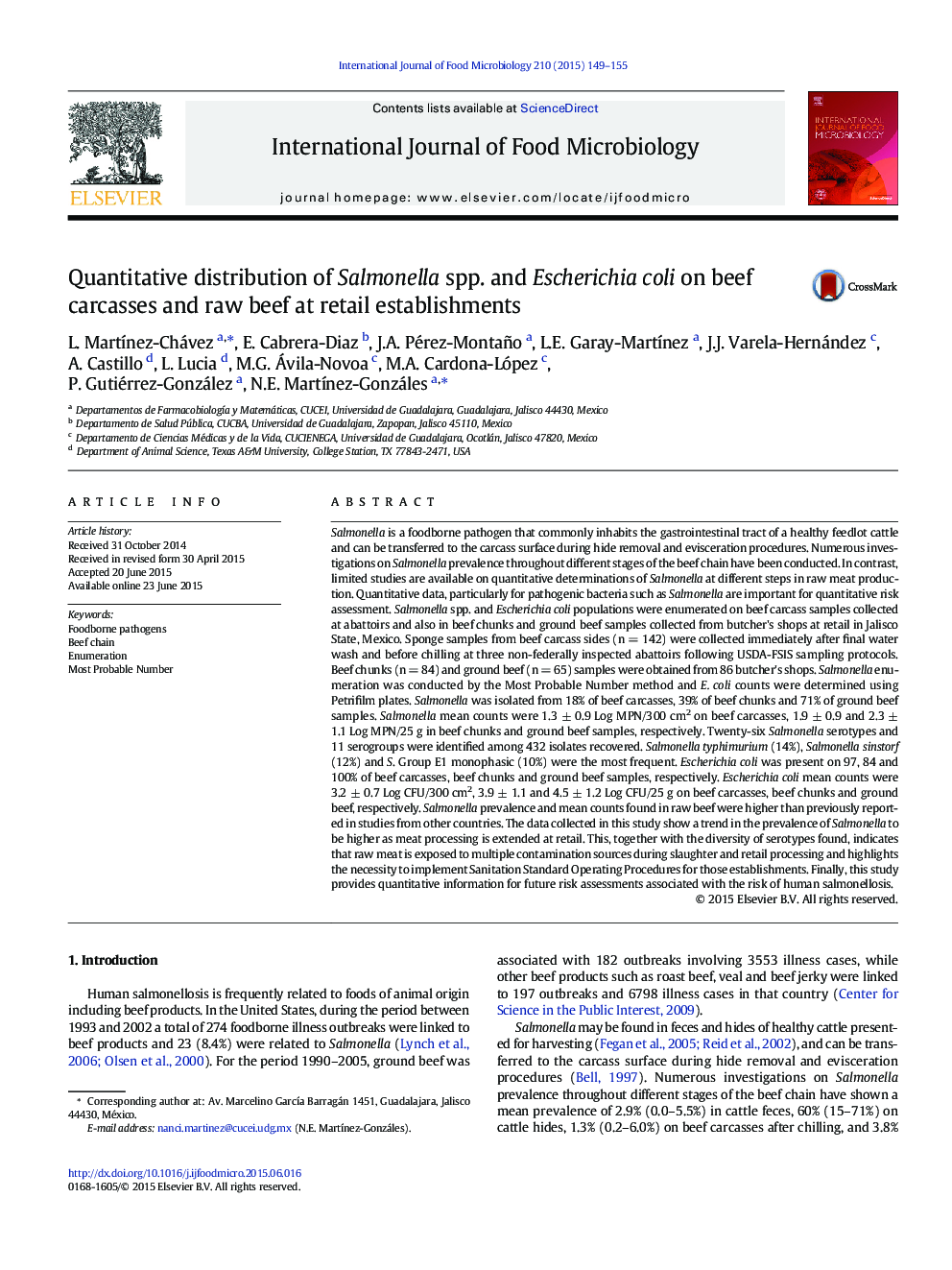| کد مقاله | کد نشریه | سال انتشار | مقاله انگلیسی | نسخه تمام متن |
|---|---|---|---|---|
| 4366498 | 1616573 | 2015 | 7 صفحه PDF | دانلود رایگان |

• Prevalence of Salmonella in raw beef products through the supply chain
• Lack of correlation between E. coli and Salmonella populations
• Increases in the prevalence and diversity of Salmonella serovars as beef is processed
• Quantitative data are suitable for risk assessments.
Salmonella is a foodborne pathogen that commonly inhabits the gastrointestinal tract of a healthy feedlot cattle and can be transferred to the carcass surface during hide removal and evisceration procedures. Numerous investigations on Salmonella prevalence throughout different stages of the beef chain have been conducted. In contrast, limited studies are available on quantitative determinations of Salmonella at different steps in raw meat production. Quantitative data, particularly for pathogenic bacteria such as Salmonella are important for quantitative risk assessment. Salmonella spp. and Escherichia coli populations were enumerated on beef carcass samples collected at abattoirs and also in beef chunks and ground beef samples collected from butcher's shops at retail in Jalisco State, Mexico. Sponge samples from beef carcass sides (n = 142) were collected immediately after final water wash and before chilling at three non-federally inspected abattoirs following USDA-FSIS sampling protocols. Beef chunks (n = 84) and ground beef (n = 65) samples were obtained from 86 butcher's shops. Salmonella enumeration was conducted by the Most Probable Number method and E. coli counts were determined using Petrifilm plates. Salmonella was isolated from 18% of beef carcasses, 39% of beef chunks and 71% of ground beef samples. Salmonella mean counts were 1.3 ± 0.9 Log MPN/300 cm2 on beef carcasses, 1.9 ± 0.9 and 2.3 ± 1.1 Log MPN/25 g in beef chunks and ground beef samples, respectively. Twenty-six Salmonella serotypes and 11 serogroups were identified among 432 isolates recovered. Salmonella typhimurium (14%), Salmonella sinstorf (12%) and S. Group E1 monophasic (10%) were the most frequent. Escherichia coli was present on 97, 84 and 100% of beef carcasses, beef chunks and ground beef samples, respectively. Escherichia coli mean counts were 3.2 ± 0.7 Log CFU/300 cm2, 3.9 ± 1.1 and 4.5 ± 1.2 Log CFU/25 g on beef carcasses, beef chunks and ground beef, respectively. Salmonella prevalence and mean counts found in raw beef were higher than previously reported in studies from other countries. The data collected in this study show a trend in the prevalence of Salmonella to be higher as meat processing is extended at retail. This, together with the diversity of serotypes found, indicates that raw meat is exposed to multiple contamination sources during slaughter and retail processing and highlights the necessity to implement Sanitation Standard Operating Procedures for those establishments. Finally, this study provides quantitative information for future risk assessments associated with the risk of human salmonellosis.
Journal: International Journal of Food Microbiology - Volume 210, 1 October 2015, Pages 149–155